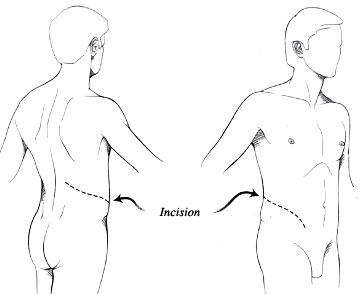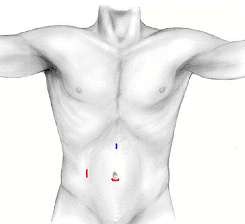Laparoscopy is a surgical procedure that uses fiber-optic instruments, inserted through the abdominal wall, in order to view organs or perform a surgical procedure. The most common procedures urologists perform laparoscopically include nephrectomy (removal of the kidney) and prostatectomy (removal of the prostate gland).
Laparoscopic and other minimally-invasive techniques are offered by Dr. Jonathan Bernie of Urology Associates of Norwalk. In addition to laparoscopic nephrectomy, Dr. Bernie has also performed laparoscopic partial nephrectomy, laparoscopic pyeloplasty, laparoscopic prostatectomy, cryoablation of the prostate, and laparoscopic renal cryoablation.
Radical nephrectomy is typically performed through a large incision (figure 1). Laparoscopic surgery (which is performed through “keyhole” incisions) provides a less invasive alternative for kidney removal (figure 2). Its advantages include less blood loss, less pain, smaller incisions, and faster recovery. The surgery is performed through small (half-inch) incisions and the tumors are eventually removed by making an incision big enough to remove the specimen. Kidney removal is performed for both cancerous (malignant) diseases as well as non-cancerous (benign) causes. Some non-cancerous conditions include chronic kidney infection, non-functioning kidneys, and renovascular hypertension. Although laparoscopy is “minimally-invasive,” it is still surgery and there are potential risks and complications.

Figure 1 - Radical Nephrectomy

Figure 2 - Laparoscopic Surgery
For patients with small tumors, removal of the tumor or destruction of the tumor tissue is an alternative to radical removal of the kidney. Destruction of kidney lesions is accomplished with heat (radiofrequency) or cold (cryosurgery) energy. Cryosurgery is a treatment option in selected patients for small kidney tumors when removing all or part of the kidney is not necessary. The kidney tumor is typically exposed laparoscopically, small probes are placed into the tumor under ultrasound and/or visual guidance, and the tumor tissue is frozen.
For more information regarding cryosurgery for both kidney and prostate cancer, visit the following site: www.oncura.com

